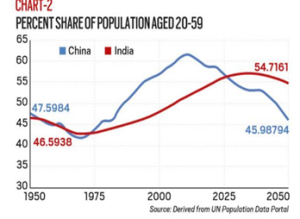(GS1: Population and related issues)
China’s population, according to its National Bureau of Statistics, fell to 1,411.8 million in 2022, from 1,412.6 million in the previous year.
- India has not conducted an official headcount Census after 2011. But going by the United Nations’ projections, its population stood at 1,417.2 million in 2022 (more than China’s) and is expected to reach 1,428.6 million in 2023
Mortality:
- A country’s population increases with a reduction in the relative number of deaths, while population growth slows/reverses with declining fertility rates.
- The crude death rate (CDR) – the number of persons dying per year per 1,000 population – was 23.2 for China in 1950 (22.2 for India). It fell to single digits of 7.3 in 2020 (7.4 for India).
- Another mortality indicator is life expectancy at birth. Between 1950 and 2020, it went up from 43.7 to 78.1 years for China and from 41.7 to 70.1 years for India.
Fertility:
- The total fertility rate (TFR) – the number of babies an average woman (aged 15-49) bears over her lifetime – was as high as 5.8 for China and 5.7 for India in 1950.
- According to its 2020 Census, China’s TFR was 1.3 births per woman.
- The TFR has fallen sharply for India too (from 3.4 to 2 between 1992-93 and 2019-21).
- A TFR of 2.1 is considered as “replacement-level fertility” – a woman having two children replaces herself and her partner with two new lives.
Issues with China’s declining population
- China’s TFR, according to its 2020 Census, was 1.3 births per woman which is marginally up from the 1.2 in the 2010 and 2000 censuses.
- Issue is that the TFR is way below the replacement rate of 2.1.
Decline working age population: The real crisis for China is the decline in its population that is of prime working age. Demographic dividend has started to reverse, and the share of China’s working-age population is projected to fall below 50% by 2045.
Opportunity for India:
- Working age population: More important is the working-age population: its share in the overall population crossed 50% only in 2007, and will peak at 57% towards the mid-2030s.
India has just begun seeing fertility rates fall to replacement levels, including in rural areas. The spread of education, farm mechanisation and fragmentation of landholdings are primary contributors to this fall.

Challenges for India:
- Productivity and economy: The youth will have to be equipped with skills that are indispensable to the knowledge economy.
- Climate change: The climate crisis and other ecological imperatives will mean that the footprints of many activities are kept light.
- State-wise focus: Much more needs to be done on this, of course, in large parts of the country, including in Uttar Pradesh, Bihar and Madhya Pradesh, whose TFR is higher than the national average and where gender discrimination has deep social roots.
- Choice to women: To actually realise Population Control, educating women and giving them freedom to make choice and implement it, should be first to have attention by the Government. States must ensure contraceptives are accessible, affordable and available in a range of forms acceptable to those using them.
Global impact of China’s population decline
- The epidemic has demonstrated how China’s internal issues can impact the flow of trade and investment, as border controls and lockdowns hurt supply chains.
- A weakening Chinese economy could undermine China’s goal to surpass the US as the greatest economy, in addition to slowing down global growth.
- In the next twenty to thirty years, China’s limited capacity to respond to this demographic shift will probably result in slower growth results and have an impact on its capacity to compete with the United States on the global stage.
- China has assumed a central position in global supply chains, so anything that affects China will have knock-on effects on the world economy.
Conclusion:
- Overall then, India has a window of opportunity well into the 2040s for reaping its “demographic dividend”, like China did from the late 1980s until up to 2015.
- However, this is entirely contingent upon the creation of meaningful employment opportunities for a young population — in the absence of which, the demographic dividend can well turn into a demographic nightmare.
